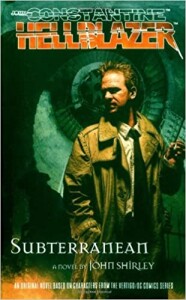 In the wake of his Constantine movie novelization, John Shirley went on to pen two original novels about Vertigo’s world-weary magus John Constantine, both published in 2006. With these novels, Shirley is clearly trying to reach two different sets of readers — established fans of Hellblazer and fans of action/adventure stories, hoping for some cross-over between the two (and not to alienate either).
In the wake of his Constantine movie novelization, John Shirley went on to pen two original novels about Vertigo’s world-weary magus John Constantine, both published in 2006. With these novels, Shirley is clearly trying to reach two different sets of readers — established fans of Hellblazer and fans of action/adventure stories, hoping for some cross-over between the two (and not to alienate either).
(A minor confession up front, I am one of those established Hellblazer fans, and have been for nearly 20 years; action/adventure novels? Not so much.)
In War Lord, Constantine finds his meditative study with a wise man known only as the Blue Sheikh cut short by the machinations of a group known as the Servants of Transformation (SoT). The group is aiming to bring about the resurrection of an ancient warlord, and in so doing, remake the world to its liking. Unknowingly, Constantine has some odd ties to the warlord in question, and he must overcome not only those bonds, but the brutal efforts of the SoT to pave the warlord’s way. In doing so, he’s handed an odd assortment of allies: a hippy American ghost, an AWOL American soldier who works well with ghosts, and an ex-lover who’s not so shabby at magic herself. The action bounces around the Middle East, Africa and France before resolving itself in London, and has a few barbed things to say about U.S. military involvement in Iraq and the hypocrisy of religious figureheads.
 Subterranean, set some time after War Lord, sees Constantine back on his home turf in England, once again forced to deal with the Servants of Transformation. This time around, the SoT have thrown their lot in with a human magus who’s found a way to prolong his life indefinitely, and who’s intent on ruling not just his own underground kingdom, but wants to subjugate those who live above ground, in Britain and beyond. It’s up to Constantine and a motley assortment of allies he finds in this Gloomlord’s kingdom to put an end to this nefarious plan, and quckly.
Subterranean, set some time after War Lord, sees Constantine back on his home turf in England, once again forced to deal with the Servants of Transformation. This time around, the SoT have thrown their lot in with a human magus who’s found a way to prolong his life indefinitely, and who’s intent on ruling not just his own underground kingdom, but wants to subjugate those who live above ground, in Britain and beyond. It’s up to Constantine and a motley assortment of allies he finds in this Gloomlord’s kingdom to put an end to this nefarious plan, and quckly.
Shirley does a decent job at capturing the feel of John Constantine (though there’s perhaps a bit too much maudlin navel gazing going on); the chapters from his point of view are definitely the best in the two novels. Of note is Constantine’s frequent use of magic — and mental powers — which may either delight or appall long-time fans used to him getting by on mostly wits. Shirley makes a valiant attempt to lay out Constantine’s past for new users and to tie those threads to current events in the novels. It works for the most part, more so in Subterranean.
The flipside of Shirley’s achievement with Constantine is that chapters concentrating on the other characters, while vital to the story, just aren’t all that engaging. He tries to make both allies and villains unique and interesting — a pair with fairy blood, a tottering old student of magic, a demon inhabiting a human body — but in the end they’re simply not terribly memorable, other than perhaps the Gloomlord himself. (And we won’t even go into the short shrift poor Chas is given in the second book.)
As for the action . . . it moves at a fairly fast pace in War Lord and as a result the novel reads more like a standard action novel than a John Constantine adventure. Things are slower, more character-driven in Subterranean, more in keeping with what a fan might expect (but perhaps not as appealing to newcomers).
On the whole, the two novels are not a bad way to kill some time. They’re probably not the best introduction to Constantine for new fans, but with any luck, those folks will go back and grab the graphic novels, see how he’s evolved over time. Longtime fans may find themselves missing the art of the graphic novels. There’s just something more powerful in seeing Constantine’s rough look and demeanor than having it spelled out in words.
(Pocket Star, 2006)
